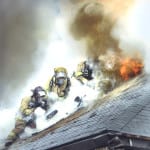 I have witnessed a rather disturbing trend in my situational awareness classes over the past year. I have added a video where firefighters are on a roof that is clearly self-venting. The video then leads us into discussions on assumed risk versus created risk and changing outcomes versus getting in the way of outcomes that are not going to be changed by the crew’s actions.
I have witnessed a rather disturbing trend in my situational awareness classes over the past year. I have added a video where firefighters are on a roof that is clearly self-venting. The video then leads us into discussions on assumed risk versus created risk and changing outcomes versus getting in the way of outcomes that are not going to be changed by the crew’s actions.
I chose this video because it is nearly indisputable that the firefighters are in a position of great danger (on a roof where a massive amount of smoke and fire are self-venting). The firefighter is adjacent to the fire (in fact, so close to the flames you have to wonder if the trim on his turnout gear melted.
The firefighter is bent over with his back to the fire, attempting to cut a hole in the roof.
A firefighter can create risk and get in the way of outcomes that cannot be changed.[tweet this]
That’s exactly what this firefighter is doing. The firefighter is eventually driven off the roof by the fire conditions without completing his task and the roof burns off the building anyhow. The small hole that he did make did nothing to improve conditions.
Five tough questions
 Some of the questions I ask the students include:
Some of the questions I ask the students include:
1. Why was the firefighter on the roof?
2. Why did the firefighter think his or her actions were the right thing to do?
3. Was it possible that the firefighter did not understand the grave danger he or she was in?
4. Is it possible the firefighter was fixated on the task and didn’t realize the fire was consuming the structural components?
5. Is it possible the firefighter was ordered to the roof and was just following those orders?
It is this last question that I want to focus on.
Just following orders, sir!
The fire service is, by many accounts, a paramilitary organization with a fixed and regimented command structure and a hierarchy for those who give orders and those who take orders. It is the job of commanders to give the orders and the job of the company officers to lead their crews in the execution of those orders. It’s not hard. Do as you’re told.
But what if an order is flawed? What if a commander’s situational awareness has been impacted and he or she does not realize executing the order will place a crew in grave danger? And what if the company officer does realizes it? What if a firefighter realizes it? Should they speak up? Would they speak up?
Speaking up
 There are two things I have been able to demonstrate during this discussion with attendees at my live events.
There are two things I have been able to demonstrate during this discussion with attendees at my live events.
First – even when gravely concerned about their safety –
Most company officers will follow the direct orders of their superior officers without question.[tweet this]
In other words, they won’t speak up even if they have significant concerns about the appropriateness of the order.
Second –
Most commanders want their subordinates to speak up if concerned about their safety.[tweet this]
At least the commanders SAID they wanted their subordinates to speak up.
There is a disconnect here. Most commanders want the company officer or firefighter to speak up yet most company officers and firefighters admit to me they would not speak up and would carry out the order even if they knew it would place them in grave danger.
Told to speak up
I have talked to many commanders about this problem. They reassure me that they tell their subordinates over and over again to speak up and it’s ok to express concerns about orders. When I ask the subordinates if they have truly been told to speak up, they often affirm that they have, indeed, been told by superiors to speak up. But would they – No.
Some things are easier said than done
As many of us know, saying we are going to do something is very different than actually doing it. We can, in our minds, talk a big game about actions we’d take or things we’d say to someone. But when it comes right down to it, many of us would cower under the stress of speaking up.
There are two main reasons why subordinates won’t speak up: 1) They don’t know how to; and, (2) They fear the consequences.[tweet this]
Chief Gasaway’s Advice
 If you want to create a culture where subordinates will speak up, and do it in a way that is courteous and respectful –
If you want to create a culture where subordinates will speak up, and do it in a way that is courteous and respectful –
We must teach our subordinates HOW to speak up when they have a concern.[tweet this]
There is a process for speaking up and that is a skill that can, and should be taught to every responder, even new recruits.
Even if someone with a concern speaks up it doesn’t mean they will do it in a way that is courteous and respectful.[tweet this]
The process is called the Five Step Assertive Statement Process and it comes from aviation.
Here are links to some articles I’ve written about this process:
Five Step Assertive Statement Process
Confronting a boss with flawed situational awareness
[Podcast] The pigs are eating lemons
(Scroll down the page to episode #12)
Learn to ask the hard questions and provoke meaningful discussions. Avoiding passing judgment and, instead, try to understand why those who have near-miss and casualty events felt that what they were doing at the time things went wrong was the right thing to do.
Action Items
 1. Discuss the hard questions that should be asked about incidents you’ve experienced in your own department.
1. Discuss the hard questions that should be asked about incidents you’ve experienced in your own department.
2. Discuss how concerns for consequences might keep a responder from speaking up.
3. Discuss how your department prepares (or does not prepare) members to speak up.
4. Create a training session where subordinates are provided with the opportunity to speak up (i.e., actually practice speaking up) to superiors.
_____________________________________________________________
The mission of Situational Awareness Matters is simple: Help first responders see the bad things coming… in time to change the outcome.
Safety begins with SA!
_____________________________________________________________
Share your comments on this article in the “Leave a Reply” box below. If you want to send me incident pictures, videos or have an idea you’d like me to research and write about, contact me. I really enjoy getting feedback and supportive messages from fellow first responders. It gives me the energy to work harder for you.
Thanks,

Email: Support@RichGasaway.com
Phone: 612-548-4424
Facebook Fan Page: www.facebook.com/SAMatters
Twitter: @SAMatters
LinkedIn: Rich Gasaway
YouTube: SAMattersTV
iTunes: SAMatters Radio


Chief
Do you have a link where we can watch the video you are referring to in this post?
To be able to watch the video would be helpful.
By the way the Plano Fire Rescue cap looks amazing on you.
Captain Richie Floyd
Station 5A
Plano Fire Rescue
Richie,
Thanks for reaching out to me. The Plano had was given to me when I taught a class there. It’s one of my favorites.
As for the video… all you have to do is go to YouTube and enter “Firefighters working on roof” in the search box and you will not run out of examples.
Rich
Riche,
I don’t have a link to the video. But you can find dozens, if not hundreds, of videos just like the one I am referencing through YouTube. Thanks for noticing the Plano cap. It’s one of my favorites!
Rich